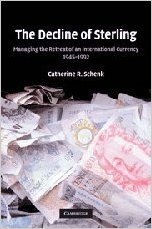 Author: Catherine R. Schenk
Author: Catherine R. Schenk
Publisher: Cambridge University Press – 437 pages
Book Review by: Sonu Chandiram
Catherine Schenk points out in this insightful and well-researched and diligently documented work that the demise of the sterling as an international currency was widely predicted in 1945 after World War II. But the process of its demise took about 30 years to complete, as discussed throughout, and in particular in chapters 9 though 12 of this book.
There has been an ongoing debate about the reasons why the retreat and demise of the sterling was so prolonged. The usual explanations put forth on why Britain’s leaders wanted to maintain a dominant position for the sterling have been along these lines:
- It increased Britain’s capacity to borrow
- It enhanced the country’s prestige
- It supported London as a global center of international finance
However the author, using data found in the financial archives of the United States, European nations, and Commonwealth countries, has put forth a strong case that argues that the sterling’s demise was due instead to the:
- Weakness of the international monetary system
- Lack of collective global interest in continuing the predominant role of the sterling
- Britain’s, and to a larger extent, the United Kingdom’s ability and effort to convince the leaders of European countries, members of the Commonwealth, the United States and other countries that the sterling was absolutely critical to maintaining the stability of the international economy
These efforts were fruitful in generating considerable, widespread support for slowing the retreat of the sterling. “This revised view has important implications for current debates over the future of the U.S. dollar as an international currency,” Schenk points out. .
In recent years, much has been debated and written about the current and future position of the United States dollar, as to whether it can continue to hold the dominant position in international finance and trade, in view of competition from China, and its borrowing ability from overseas as a consequence of the soaring $20-trillion-dollar U.S. government debt that many economists have described as ‘unsustainable’.
This compact book of about 400+ pages contains 12 chapters in three Parts we list below to give you an overview of its contents:
- Introduction
- Part I. Reconstructing the International Monetary System: 1945-1959
- The post-war international monetary system 1945-1950
- The return to convertibility 1950-1959
- Part II. Accelerating the Retreat
- Sterling and European Integration
- The 1967 sterling devaluation: relations with the United States and the IMF 1964-1969
- Sterling and the City
- Multinational negotiations: sterling and the reform of the international monetary system
- The Sterling Agreements of 1968
- Sterling’s Final Retreat 1970-1992
- Sterling and the end of Bretton Woods
- Years of crisis 1973-1979
- The aftermath 1980-1992
- Summary and overview
This book contains large amounts of data in the form of charts and tables, and footnote to various sources that support and shed light on the points made in it. The discussions of the topics are greatly enhanced by the tremendous, brilliant scholarship effort of the author.
It is a significant contribution to the history of the sterling in particular, and world economic history in general The British sterling played a major role for in the international financial system many decades. We congratulate Catherine Schenk for this accomplishment.
Author:
Catherine R. Schenk is Professor of International Economic History at the University of Glasgow. She has held economic posts in the United Kingdom, New Zealand, and Malaysia, and has been a visiting researcher at the Hong Kong Institute for Monetary Research and the International Monetary Fund. Her previous books include Hong Kong as an International Financial Center (2001) and Britain and the Sterling Area (1994).






